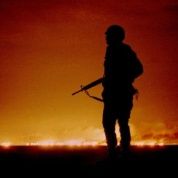The name Operation Desert Storm was thought up by some public relations office in or near the Pentagon: America’s Ministry of Defense. It was emblazoned on t-shirts and hats across the United States. It was America’s new moment as a great nation, characterized by its endless need for war, enemies, and states of emergency, key to drumming up money and nationalist craze.

For Iraqis, the days leading up to the deadline of Jan. 15, 1991, were filled with terror and uncertainty. Most knew that Saddam would not withdraw, and this mass buildup of firepower would eventually erupt in their skies, on their heads, and through their windows. International news agencies covered the war like cheerleaders celebrating the buildup to a sporting event. Press releases from American officials constructed a discourse that was familiar, but for the first time, would be consumed with little or no resistance.
Iraq was sketched out as the enemy, and America was marketed as the superhero, ready to protect the world from this new scourge. A dichotomy fueled by racism and violence, the two cornerstones of American foreign policy. Under the spotlights of cameras and at the behest of an adrenalin-pumped army equipped with the most advanced arsenal of arms known to mankind, the deadline for Saddam to withdraw from Kuwait conveniently passed, and on Jan. 16, 1991, Operation Desert Storm would erupt.
America led a coalition, authorized by the United Nations, in a military campaign that would kill over a hundred thousand Iraqis in just over a month. For the first time in history, a mass murder of this scale was televised to global audiences around the clock. Bombs were outfitted with cameras, military officials took over the airwaves, and reporters were put into tanks and on battleships like never before.
For people sitting at home, it was a new form of entertainment that would reshape the news industry and the way we consume information in a fundamental way. Viewers would no longer be sufficed with short summaries of the daily news, nor did they care about any form of analysis, they wanted to watch the war like a reality TV show broadcast 24 hours a day with all the engineered emotions and reactions that came with it.
For Iraqis, Operation Desert Storm, or the Gulf War as it was known by cheeky pundits, was the most violent campaign of terrorism they had yet to endure. Jet fighters from around the world didn’t give the Baghdad sky a rest, and dropped bombs on homes, water treatment plants, power stations, cement plants, medicine factories, refineries, radio and telephone networks, airports, railways and bridges.
On Feb. 13, 1991, the United States Air Force dropped two laser guided “smart bombs” into the Amiriyah Bomb Shelter, a large bunker used by civilians in a western neighborhood of Baghdad. That night, 408 civilians, mostly women and children, were burned to death in a calculated attack that was intended to break the people of Iraq. America would claim that the bunker was being used by Saddam’s military intelligence, and Saddam would deny this, and this was an embodiment of how everyday Iraqis were paying the price for a military production co-produced by the Pentagon and Saddam.
More firepower was used against Iraq in 44 days than throughout the entire Second World War, and that was a war that lasted four years and included the use of two nuclear bombs in the Japanese cities of Hiroshima and Nagasaki.

Everything that was vital to a dignified life was destroyed. The Gulf War specifically targeted civilians. The campaign was not limited to Baghdad. It was felt throughout Iraq, and it was meant to fulfill the promise of the American Secretary of State at the time, James Baker, which was to reduce Iraq to the pre-industrial age.
Although the destruction in Iraq was quantifiable in blood and stone, the political ramifications that the war had on the region was very tangible as well. In the words of America’s president at the time, George Bush Sr., the Gulf War ushered in a “New World Order.” The United States would build a series of permanent military bases throughout the oil rich states of the Gulf, and the use of military power would solidify itself in the lexicon of world politics alongside terms such as “Liberation,” and “Humanitarian Intervention.” America would emerge from the Gulf War as the new emperor of the world, and Iraq would be forever doomed to live at the mercy of its rulers.
Whereas the people of Iraq were busy trying to glue their lives together in the aftermath of the war, Saddam emerged as a strengthened despotic ruler of the country, and, in his mind, comfortably claimed the status of defender of the Global South in the eyes of millions of oppressed peoples around the world desperately seeking dignity and a hero.
During the war, Americans had theatrically urged Iraqis to rise up, and they did, only to be crushed by Iraqi helicopters that were permitted to fly by the United States themselves.
In a finale fit for horror films, the American Air Force obliterated retreating Iraqi troops from Kuwait along what would be forever known as the Highway of Death. Tens of thousands of young Iraqi men, forced into military service, were murdered in a mass act of sacrifice to the gods of war and violence. They were hungry, tired, and ill-prepared soldiers, many of whom were walking back to their homes across different cities in Iraq.
With this final act of terror, the “liberation” of Kuwait was complete, and Iraq would enter into a new era of genocide, under the United Nations imposed sanctions that would haunt its people throughout the Nineties.
Reprinted with permission from “A Dummy’s Guide To Iraq” published in shakomako.net.